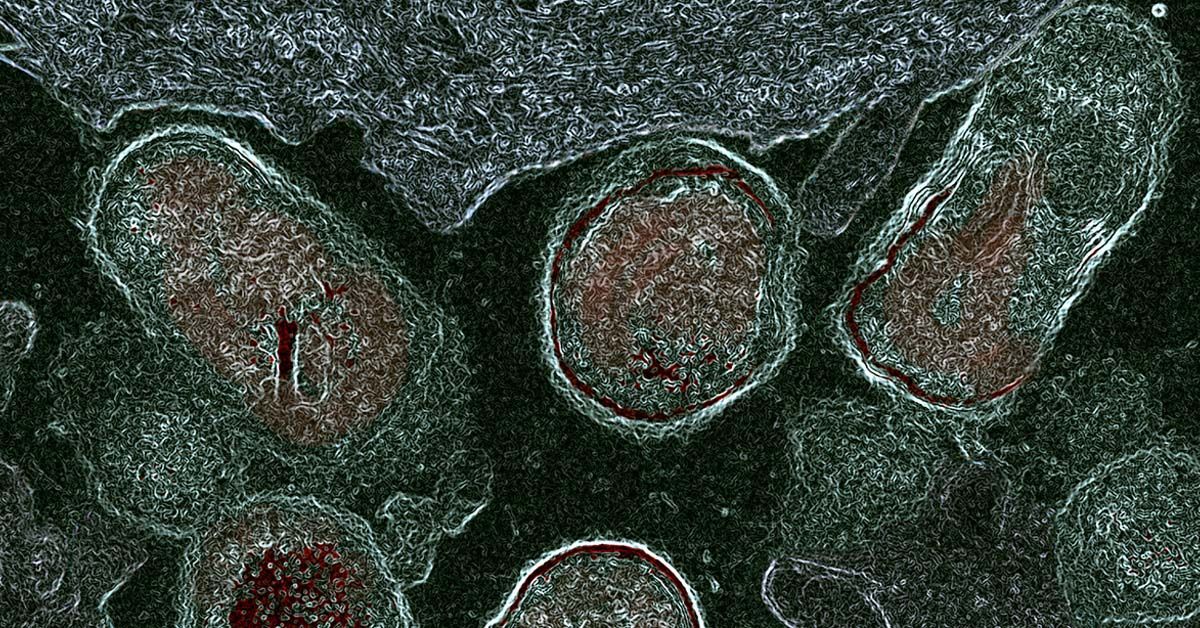2023-11-29 カリフォルニア大学サンディエゴ校(UCSD)
 In bacterial vaginosis, bacteria (bottom) attack the surface of epithelial cells in the vagina (top). This phenomenon could help explain why bacterial vaginosis is associated with many poor health outcomes. Photo credit: UC San Diego Health Sciences
In bacterial vaginosis, bacteria (bottom) attack the surface of epithelial cells in the vagina (top). This phenomenon could help explain why bacterial vaginosis is associated with many poor health outcomes. Photo credit: UC San Diego Health Sciences
◆バクテリア性膣症は生殖年齢の女性の中で一般的であり、米国では約29%に影響するとされています。研究者は膣上皮細胞の表面を詳細に調査し、バクテリアが細胞表面の糖鎖(グリカン)を分解する酵素を放出することを明らかにしました。この研究は、バクテリア性膣症の診断やリスクの高いサブグループの特定に寄与する可能性があります。
<関連情報>
- https://today.ucsd.edu/story/breaking-down-barriers-what-happens-when-the-vaginal-microbiome-attacks
- https://www.science.org/doi/10.1126/scitranslmed.abp9599
常在微生物が膣上皮のグリカン構造を形成する Resident microbes shape the vaginal epithelial glycan landscape
Kavita Agarwal,Biswa Choudhury,Lloyd S. Robinson,Sydney R. Morrill,Yasmine Bouchibiti,Daisy Chilin-Fuentes,Sara B. Rosenthal,Kathleen M. Fisch,Jeffrey F. Peipert,Carlito B. Lebrilla,Jenifer E. Allsworth,Amanda L. Lewis,and Warren G. Lewis
Science Translational Medicine Published:29 Nov 2023
DOI:https://doi.org/10.1126/scitranslmed.abp9599
Editor’s summary
During bacterial vaginosis (BV), an overgrowth of bacteria resides on affected epithelial surfaces, which are prone to increased shedding of cells. Agarwal et al. surveyed the glycans (carbohydrates) covering vaginal epithelial cells in human BV and found depletion of sialic acid residues, resulting in overall diminished protective glycocalyx. Treatment of healthy vaginal epithelial cells with recombinant Gardnerella sialidases recapitulated BV-like desialyated glycans and altered epithelial cell gene expression pathways regulating cell death, differentiation, and inflammatory responses. This work suggests that the action of bacterial sialidases on vaginal surfaces may underlie the aberrant epithelial pathophysiology observed in BV. -Catherine Charneski
Abstract
Epithelial cells are covered in carbohydrates (glycans). This glycan coat or “glycocalyx” interfaces directly with microbes, providing a protective barrier against potential pathogens. Bacterial vaginosis (BV) is a condition associated with adverse health outcomes in which bacteria reside in direct proximity to the vaginal epithelium. Some of these bacteria, including Gardnerella, produce glycosyl hydrolase enzymes. However, glycans of the human vaginal epithelial surface have not been studied in detail. Here, we elucidate key characteristics of the “normal” vaginal epithelial glycan landscape and analyze the impact of resident microbes on the surface glycocalyx. In human BV, glycocalyx staining was visibly diminished in electron micrographs compared to controls. Biochemical and mass spectrometric analysis showed that, compared to normal vaginal epithelial cells, BV cells were depleted of sialylated N– and O-glycans, with underlying galactose residues exposed on the surface. Treatment of primary epithelial cells from BV-negative women with recombinant Gardnerella sialidases generated BV-like glycan phenotypes. Exposure of cultured VK2 vaginal epithelial cells to recombinant Gardnerella sialidase led to desialylation of glycans and induction of pathways regulating cell death, differentiation, and inflammatory responses. These data provide evidence that vaginal epithelial cells exhibit an altered glycan landscape in BV and suggest that BV-associated glycosidic enzymes may lead to changes in epithelial gene transcription that promote cell turnover and regulate responses toward the resident microbiome.


